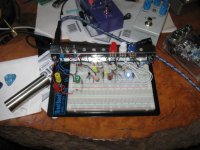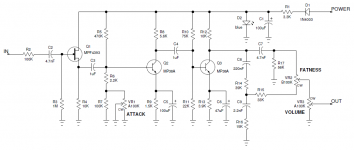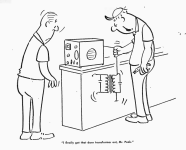Chuck D. Bones
Circuit Wizard
I've been messing around with some old-school fuzzes for a while with less than satisfying results. Then I took a stab at the FZ-1A. The original was built with three PNP germanium transistors. Tried that on a breadboard but the sound was not good. I started searching for information on how that pedal should be biased. The first place I landed was on Smallbear's Fuzz-E-One project page. Very enlightening, Anyone building a leakage-biased circuit would do well to read that article. Turns out the transistors I had were not nearly leaky enough. This was the first time I had trouble finding Ge transistors in my stash that had high enough leakage. In fact, none of my PNPs passed muster, but I had some Soviet MP38A's that would work. Those are NPN, so I switched the polarities, followed Steve Daniels instructions on biasing and voilà! There was that buzz-saw "Satisfaction" tone I was after!
I wanted to fatten up the tone a bit. The bass is choked off by the last capacitor, just before the VOLUME control. I tried putting in the FATNESS control from Roger Mayer's Page-1 fuzz. Worked very well restoring the bottom end. I tweaked some of the R & C values a little bit to my taste. Roger's FATNESS control resembles the BMP Tone control, but with some important differences that make the full range useful. Roger Mayer is a genius.
At high gain it was a bit noisy, so I swapped in a JFET in the first stage. It's just an emitter follower, so going to a source follower didn't affect the tone other than making the noise all but disappear. I had to reduce C2 to get the low-end rolloff back to 60Hz.
At this point, it was time to layout a Vero board.
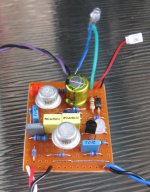
Since I had dialed-in the bias on the breadboard, I used the same transistors and resistors from the breadboard to build the Vero. For that reason, I skipped socketing the transistors.
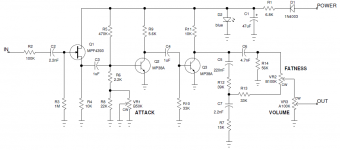
That blue LED on the board (D2) acts as a 3V shunt regulator. I was out of 2.2nF caps, so I subbed 2.7nF on the board. R9 & R10 were selected in test to fine-tune the bias on Q2 & Q3, respectively.
I think I'm going to change the ATTACK pot to A50K; the bottom end of rotation is pretty touchy. Controls are (L-R) VOLUME, ATTACK, FATNESS.
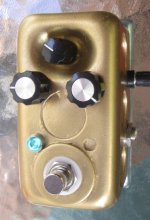
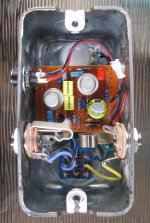
It doesn't have a name or labels yet.
If you're interested in building an FZ-1 type fuzz, the DAM FZ-673 is based on the FZ-1 and is available from PedalPCB as the Kilimanjaro Fuzz. Same goes for the Sola Sound Tone Bender Mark II a.k.a. Tone Vendor Mark II.
I thought I'd throw in a little discussion on PNP vs. NPN.
Back in the early 60's, transistor technology was pretty immature. Transistor were all germanium and the PNP ones had superior gain and noise performance. At the time, pedal builders had no choice but to use germanium PNP. PNP circuits tended to be designed with positive ground. Into the 70's, transistor design and manufacturing improved significantly. Transistor performance was getting better and better. Gain and bandwidth were going up, noise and leakage were going down and NPNs were just as good as PNPs, sometimes better. Silicon transistors had come on the scene and for most, but not all applications, silicon was vastly superior. Still, some pedal builders stuck to the old ways because there was something special about the tone of germanium transistor pedals, temperature drift notwithstanding. Almost all pedals were battery powered, and the ones that weren't had their own dedicated power supply built-in. Ground polarity was not an issue because pedals did not share a common power supply. Then along come the Boss pedals with power connectors on the side. If you daisy-chain the power to all of the pedals on your board, they had better all have the same ground polarity. Negative ground became the de facto standard. The old PNP-based pedals had positive ground, so what to do? Most builders stuck with vintage PNP transistors and added voltage inverters, like we see in the Kilimanjaro. There's no such thing as a free lunch, and in this case, the price to be paid is the extra expense and noise of the inverter. But there were some clever builders out there, like Jorge Tripps of Way Huge, who took advantage of the fact that as far as the signal is concerned, power and ground can be interchangeable. Take a look at the Way Huge Conquistador Fuzztortion (PedalPCB Vanquisher). It's all PNP, just turned upside-down to make the ground negative without using an inverter chip. The only catch is the power rail needs to be very clean. Not hard to do and in transistor-based pedals, clean power rails is already a requirement anyway. I started out with my FZ-1A breadboard using PNP transistors, upside-down with negative ground. But alas, I didn't have PNPs with enough leakage, so I switched over to NPN. Unless you are obsessed with using the exact same Ge PNP transistor part number that was used in those vintage pedals, I'm sure that you can find an NPN Ge that will sound just as good. I'm not advocating one vs. the other, just pointing out that there are options. For example, the Kilimanjaro could easily be built with NPN transistors and no inverter chip if you were so inclined.
I wanted to fatten up the tone a bit. The bass is choked off by the last capacitor, just before the VOLUME control. I tried putting in the FATNESS control from Roger Mayer's Page-1 fuzz. Worked very well restoring the bottom end. I tweaked some of the R & C values a little bit to my taste. Roger's FATNESS control resembles the BMP Tone control, but with some important differences that make the full range useful. Roger Mayer is a genius.
At high gain it was a bit noisy, so I swapped in a JFET in the first stage. It's just an emitter follower, so going to a source follower didn't affect the tone other than making the noise all but disappear. I had to reduce C2 to get the low-end rolloff back to 60Hz.
At this point, it was time to layout a Vero board.

Since I had dialed-in the bias on the breadboard, I used the same transistors and resistors from the breadboard to build the Vero. For that reason, I skipped socketing the transistors.

That blue LED on the board (D2) acts as a 3V shunt regulator. I was out of 2.2nF caps, so I subbed 2.7nF on the board. R9 & R10 were selected in test to fine-tune the bias on Q2 & Q3, respectively.
I think I'm going to change the ATTACK pot to A50K; the bottom end of rotation is pretty touchy. Controls are (L-R) VOLUME, ATTACK, FATNESS.


It doesn't have a name or labels yet.
If you're interested in building an FZ-1 type fuzz, the DAM FZ-673 is based on the FZ-1 and is available from PedalPCB as the Kilimanjaro Fuzz. Same goes for the Sola Sound Tone Bender Mark II a.k.a. Tone Vendor Mark II.
I thought I'd throw in a little discussion on PNP vs. NPN.
Back in the early 60's, transistor technology was pretty immature. Transistor were all germanium and the PNP ones had superior gain and noise performance. At the time, pedal builders had no choice but to use germanium PNP. PNP circuits tended to be designed with positive ground. Into the 70's, transistor design and manufacturing improved significantly. Transistor performance was getting better and better. Gain and bandwidth were going up, noise and leakage were going down and NPNs were just as good as PNPs, sometimes better. Silicon transistors had come on the scene and for most, but not all applications, silicon was vastly superior. Still, some pedal builders stuck to the old ways because there was something special about the tone of germanium transistor pedals, temperature drift notwithstanding. Almost all pedals were battery powered, and the ones that weren't had their own dedicated power supply built-in. Ground polarity was not an issue because pedals did not share a common power supply. Then along come the Boss pedals with power connectors on the side. If you daisy-chain the power to all of the pedals on your board, they had better all have the same ground polarity. Negative ground became the de facto standard. The old PNP-based pedals had positive ground, so what to do? Most builders stuck with vintage PNP transistors and added voltage inverters, like we see in the Kilimanjaro. There's no such thing as a free lunch, and in this case, the price to be paid is the extra expense and noise of the inverter. But there were some clever builders out there, like Jorge Tripps of Way Huge, who took advantage of the fact that as far as the signal is concerned, power and ground can be interchangeable. Take a look at the Way Huge Conquistador Fuzztortion (PedalPCB Vanquisher). It's all PNP, just turned upside-down to make the ground negative without using an inverter chip. The only catch is the power rail needs to be very clean. Not hard to do and in transistor-based pedals, clean power rails is already a requirement anyway. I started out with my FZ-1A breadboard using PNP transistors, upside-down with negative ground. But alas, I didn't have PNPs with enough leakage, so I switched over to NPN. Unless you are obsessed with using the exact same Ge PNP transistor part number that was used in those vintage pedals, I'm sure that you can find an NPN Ge that will sound just as good. I'm not advocating one vs. the other, just pointing out that there are options. For example, the Kilimanjaro could easily be built with NPN transistors and no inverter chip if you were so inclined.
Last edited:


